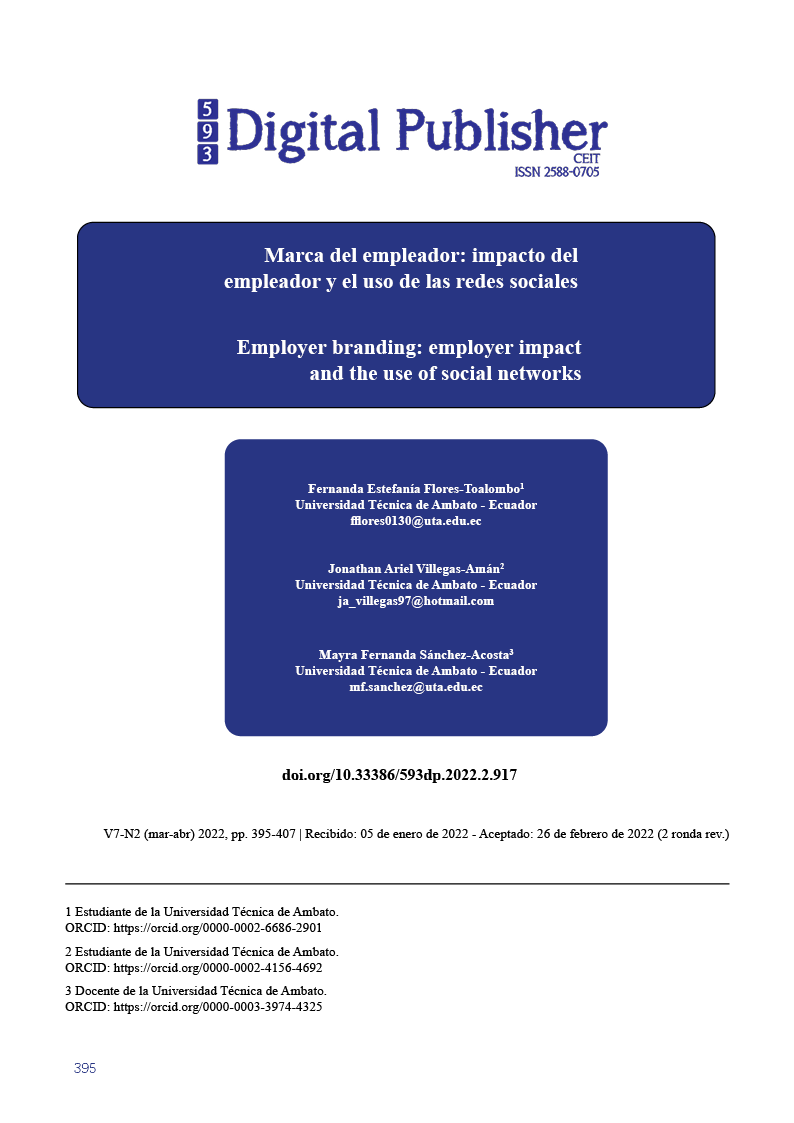Employer branding: employer impact and the use of social networks
Main Article Content
Abstract
Employer branding has allowed companies to highlight an attractive profile on social networks as a strategy to recruit potential candidates. In addition, it requires highlighting corporate reputation since it is an element that influences applicants to apply for a job vacancy. The objective of the study was to identify the perceptions of potential collaborators about employers and their intentions to apply for a job within the commercial sector in the province of Tungurahua. The employer attractiveness model (EmpAt), which evaluated the value of interest, social, economic, development and application, was applied using the statistical technique of factor analysis. The results reflected that the interest, economic, development, and practical value influence candidates to apply for a job in social networks. However, the social value was determined as a factor that has not influenced the behavior of potential applicants. It was concluded that applicants for a job in the commercial sector have taken into consideration the evaluation factors, however, a peculiar attitude was found, since the relationship between colleagues has not been considered relevant, although they demonstrated a positive attitude towards working, meeting objectives and receiving remuneration as the main elements of application.
Downloads
Article Details

This work is licensed under a Creative Commons Attribution-NonCommercial-ShareAlike 4.0 International License.
1. Derechos de autor
Las obras que se publican en 593 Digital Publisher CEIT están sujetas a los siguientes términos:
1.1. 593 Digital Publisher CEIT, conserva los derechos patrimoniales (copyright) de las obras publicadas, favorece y permite la reutilización de las mismas bajo la licencia Licencia Creative Commons 4.0 de Reconocimiento-NoComercial-CompartirIgual 4.0, por lo cual se pueden copiar, usar, difundir, transmitir y exponer públicamente, siempre que:
1.1.a. Se cite la autoría y fuente original de su publicación (revista, editorial, URL).
1.1.b. No se usen para fines comerciales u onerosos.
1.1.c. Se mencione la existencia y especificaciones de esta licencia de uso.
References
Alvino, C. (5 de Mayo de 2021). Estadísticas de la situación digital de Ecuador en el 2020-2021. Branch Group - Agencia de Marketing Digital Medellín Colombia: https://branch.com.co/marketing-digital/estadisticas-de-la-situacion-digital-de-ecuador-en-el-2020-2021/
Améstica, L., & King, A. (2017). Importancia y valor económico de la marca en el sistema universitario. Revista de Ciencias Humanas y Sociales, 83, 545-571. https://dialnet.unirioja.es/servlet/articulo?codigo=6228349
Ancin, I. (2018). Relación de las características de las generaciones “X” y “Y” con las decisiones de selección de personal y su desarrollo laboral. Revista Caribeña de Ciencias Sociales, en linea.
Backhaus, K. (2016). Employer Branding Revisited. Organization Management Journal, 13(4), 193-201. http://sedici.unlp.edu.ar/handle/10915/58264
Backhaus, K., & Tikoo, S. (2004). Conceptualizing and researching employer branding. Career Development International, 9(5), 501–517. https://doi.org/10.1108/13620430410550754
Baladán, F., & Hernández, J. (2016). Nuevas manifestaciones del relacionamiento laboral: e-recruiting, reputación digital, trabajo 3.0 y relaciones laborales en la economía colaborativa. [Discurso principal] Conferencia Simposio, Universidad Nacional de la Plata: http://sedici.unlp.edu.ar/handle/10915/58264
Bazán, V., Hermoso, R., & Escario, I. (2018). E-recruitment en España: Evolución y uso de las TIC para atraer candidatos. Acciones e Investigaciones Sociales(39), 201-222. https://despapiro.unizar.es/ojs/index.php/ais/article/view/3238
BeeDigital. (2021). La estrecha relación de las redes sociales y el mundo laboral. BeeDIGITAL, https://www.beedigital.es/redes-sociales-pymes-autonomos/la-estrecha-relacion-de-las-redes-sociales-y-el-mundo-laboral/.
Berthon, P., Ewin, M., & Hah, L. (2005). Captivating Company: dimensions of attractiveness in employer branding. International Journal of Advertising, 24(2), 151-172. https://doi.org/10.1080/02650487.2005.11072912
Costa, C. (2019). Comunicación de crisis, redes sociales y reputación corporativa. España: ESIC Editorial.
Deepa, R., & Rupashree, B. (2017). A Comprehensive Framework for Implementing an Effective Employer Brand Strategy. Global Business Review, 18(3), 75-94. https://doi.org/10.1177/0972150917693152
Duràn, I., Gallegos, M., Dauvin, G., & Rojas, J. (2020). Valoración de los factores que determinan la atracción laboral de las empresas Valoración de los factores que determinan la atracción laboral de las empresas desde la perspectiva de los futuros colaboradores. Formación Universitaria, 13(5), 15-26. DOI:10.4067/S0718-50062020000500015
Eger, L., Mičík, M., Gangur, M., & Řehoř, P. (2019). Employer Branding: Exploring Attractiveness Dimensions in a Multicultural Context. Technological and Economic Development of Economy, 25(3), 519-541. DOI: https://doi.org/10.3846/tede.2019.9387
ESAN. (2020). Reclutamiento y selección: impacto de las redes sociales. Conexión ESAN, https://www.esan.edu.pe/apuntes-empresariales/2020/03/reclutamiento-y-seleccion-impacto-de-las-redes-sociales/.
Freile, M. (2020). La marca empleador en la administración pública de Ecuador. Análisis del concepto y medición de su valor. [Tesis Doctoral, Universidad Complutense de Madrid]. https://eprints.ucm.es/id/eprint/64221/
Gimeno, T. (2018). La guía suprema del Employer Branding digital. Academia edu, 1-43.
Hanze, E. (2020). El reclutamiento a través de redes sociales como nueva tendencia en la selección de personal y su aplicación en la empresa Tata Consultancy Services Ecuador. [Tesis de Maestria, Universidad Andina Simón Bolívar] https://repositorio.uasb.edu.ec/handle/10644/7873
Hernández Sampieri, R., Fernández, C., & Baptista, P. (2014). Metodología de la Investigación (Sexta ed.). Mexico: McGRAW-HILL.
Kucherov, D., Zamulin, A., & Tsybova, V. (2019). How Young Professionals Choose Companies: Employer Brand and Salary Expectations. Russian Management Journal, 17(1), 29-46. DOI: https://doi.org/10.21638/spbu18.2019.102
Liu, Y. (2018). Employer Attractiveness to Chinese Potential Employees. European Journal of Interdisciplinary Studies, 4(2), 147-155. DOI: https://doi.org/10.26417/ejis.v4i2.p147-155
Mababu, R. (2016). Reclutamiento a través de las redes sociales: Reclutamiento 3.0. Opción, 32(10), 135-151. https://www.redalyc.org/articulo.oa?id=31048901008
Mejía, J. C. (17 de Marzo de 2021). Estadísticas de redes sociales 2021: usuarios de Facebook, Instagram, Youtube, LinkedIn, Twitter, TikTok y otros. Juan Carlos Mejía https://www.juancmejia.com/marketing-digital/estadisticas-de-redes-sociales-usuarios-de-facebook-instagram-linkedin-twitter-whatsapp-y-otros-infografia/#3_Usuarios_activos_de_LinkedIn
Miyashiro Goyzueta, H. (2017). Planificación estratégica de relaciones públicas y la reputación corporativa en el corporativo empresarial peruano. Revista de la Asociación de Docentes de la USMP, 31, 87-113. doi.org/10.24265/cultura.2017.v31.05
Montes, G. (2020). Employer branding digital y la atracción y retención de talento. Especial referencia al Plan de Igualdad. Relaciones Laborales y Derecho del Empleo, 8(4), 222-244. http://ejcls.adapt.it/index.php/rlde_adapt/article/view/920
Morales, V., & Pérez, M. (2019). Reclutamiento 2.0. TEPEXI Boletín Científico De La Escuela Superior Tepeji Del Río, 6(12), 99-101. https://doi.org/10.29057/estr.v6i12.4262
Primicias Ec. (2019). Las redes sociales pueden arruinar sus oportunidades de conseguir un empleo. Primicias Ec, https://www.primicias.ec/noticias/tecnologia/atencion-lo-que-publica-en-redes-sociales-puede-arruinar-su-carrera/.
Santarriaga, M., & Soto, F. (2019). Motivaciones de visita de los miembros de las comunidades de marca virtuales a través de las redes sociales y su relación con la intención de compra, reclutamiento y recomendación boca a boca. Revista Perspectivas SciElo(44), 73-100. http://www.scielo.org.bo/scielo.php?pid=S1994-37332019000200004&script=sci_arttext
Tumbaco, N. (2018). Redes sociales como fuente de reclutamiento para las áreas de Recursos Humanos. Artículo de Masterado, Universidad de Especialidades Espiritu Santo: http://repositorio.uees.edu.ec/handle/123456789/2567



